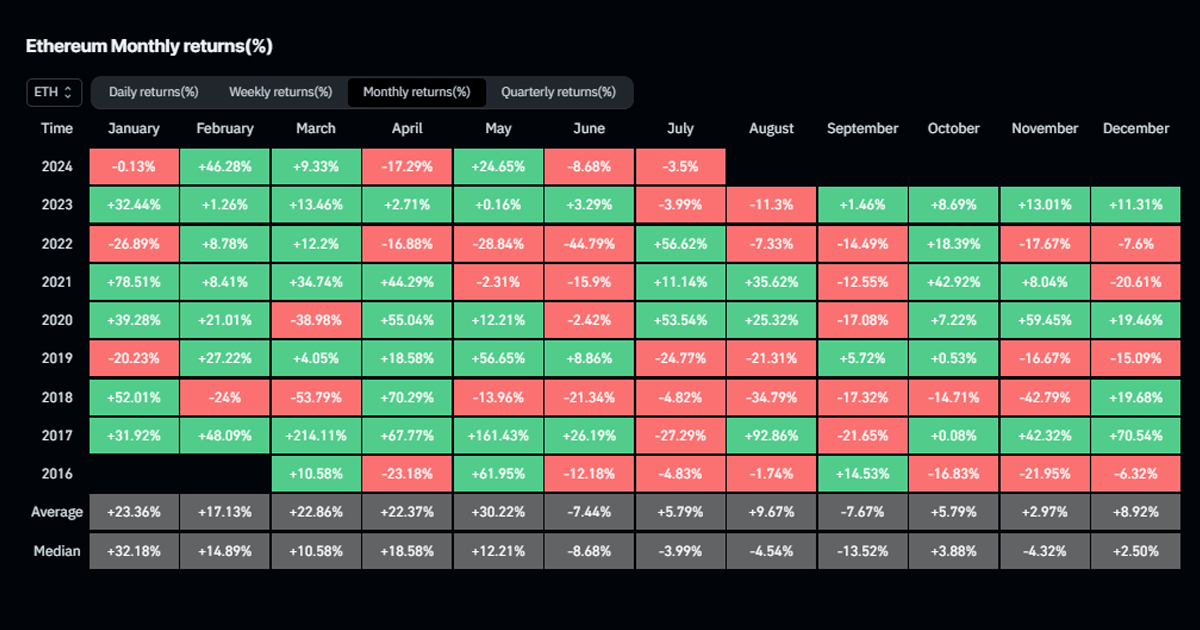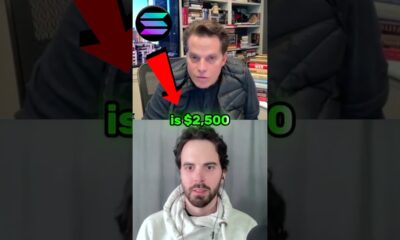Ethereum
Put ETH aside, SOL is the new supercurrency

Executive summarySolana, the fourth-largest cryptocurrency by market cap, is a blazing-fast and cost-effective blockchain network that has positioned itself as a serious competitor to Ethereum. Recent on-chain metrics reflect Solana’s growing influence and competitive position. However, Solana faces challenges including centralization issues, an inflationary token model, and past network instability. The Firedancer protocol aims to address centralization issues by introducing a second validator client and supporting sharding to improve scalability.
These network upgrades have resulted in positive growth, demonstrated by increases in key on-chain metrics such as total value locked (TVL), decentralized exchange (DEX) volume, and daily fee payers. With growing institutional interest and continued upgrades, Solana is actively working to overcome its limitations and solidify its position as a leading Layer 1 blockchain.
Top Cryptocurrencies to Watch: Insider Tips and Strategies
Discover the best crypto projects to watch and key strategies for investing in the ever-changing cryptocurrency market. This video covers the most promising DeFi tokens, gaming coins, eco-friendly cryptocurrencies, and privacy coins. Learn how social media trends, technological advancements, and major partnerships are influencing the market. Explore the future of NFTs, the metaverse, and layer-1 and layer-2 solutions like Solana and Polygon. Gain valuable insights to help you make informed investment decisions and stay ahead of the crypto space.
Solana vs Ethereum: A comparison
Among the thousands of crypto projects today, Solana and Ethereum are two notable networks. Both are major Layer 1 blockchains with vibrant communities and a wide range of projects in various Web3 niches, including DeFi, NFTs, and Web3 gaming. Despite Ethereum’s first-mover advantage, Solana has gained prominence due to its scalability and speed, often dubbed the “Ethereum killer.”
Understanding the Blockchain Trilemma
To understand the differences between Solana and Ethereum, it’s essential to consider the blockchain trilemma. Coined by Ethereum co-founder Vitalik Buterin, this concept suggests that decentralized blockchains must balance three main factors: security, decentralization, and scalability, often compromising one to improve another.
Why Privacy Coins Are the Future of Cryptocurrency Investments?
Explore the world of privacy cryptocurrencies and learn how they offer true financial secrecy. Unlike traditional cryptocurrencies, privacy cryptocurrencies like Monero, Zcash, and Dash hide transaction details to keep your financial activities private. Learn about their unique features, the regulatory landscape, and why investing in these cryptocurrencies can be a smart move to maintain privacy and diversify your portfolio.
Ethereum uses a Proof of Stake (PoS) consensus mechanism in which validators stake ETH to verify transactions, ensuring security in the event of potential loss of staked tokens due to malicious actions. This evolved from its original Proof of Work (PoW) system. Solana combines Proof of History (PoH) with Delegated Proof of Stake (dPoS), creating a verifiable record of time between transactions and increasing the cost of malicious actions. Despite its innovative approach, Solana has faced challenges such as network outages and a smaller validator pool compared to Ethereum. In terms of decentralization, Ethereum has a large network of globally distributed nodes and validators, preventing any single entity from controlling the network. Solana, with a smaller validator pool, faces centralization issues, which it aims to mitigate through protocols like Firedancer to improve resiliency and enable more validators.
When it comes to scalability, Ethereum handles 15-30 transactions per second (tps) with gas fees varying based on congestion. In contrast, Solana handles up to 65,000 tps with minimal fees, thanks to innovations like PoH and Tower Byzantine Fault Tolerance (BFT), making it a cost-effective platform for various dApps.
Network Measurements and Adoption
Solana has shown strong growth in its financial metrics. While DeFi’s total value locked (TVL) fell 9% QoQ to $4.5 billion, it increased 26% in SOL terms. The average daily spot trading volume on decentralized exchanges (DEXs) increased 32% to $1.6 billion.
Network metrics point to increased activity. The number of active daily fee payers increased 51% from the previous quarter to 900,000, and the number of new daily fee payers jumped 114% to 247,000. Despite congestion from spam transactions, the network maintained an average of 70 million daily non-voting transactions. Active addresses also increased significantly, from 1.2 million in mid-April to 1.9 million in mid-July.
Adoption metrics highlight Solana’s growing influence across a variety of industries. In the decentralized physical infrastructure network (DEPin) sector, achievements include Helium Mobile’s new licensing program, Shaga’s $1 million fundraise, and the launch of the io.net token with a market cap of $325 million. Memecoin trading continues to drive DEX activity, with notable tokens including WIF, MEW, POPCAT, and GME. Additionally, Pump.fun, a gamified token launch platform, collected $48 million in fees in Q2, averaging $525,000 in daily fees.
Solana Technical Analysis
Solana has recently posted impressive performance, generating a return of 16.2% in the past week. Market sentiment towards Solana and its tokens, including SOL-based meme coins, remains very bullish. This has driven up the prices of key coins in the Solana ecosystem like Jupiter, Radium, and Ponke.
Technically, SOL has formed a large symmetrical triangle on the daily chart. In this pattern, a double bottom formation has appeared, signaling a bullish breakout. SOL has moved from $135 to $185 and, after retesting $172, it is challenging the $185 level again. The next target is $200, with the possibility of revisiting this year’s all-time high of $210.
Major indicators support this bullish outlook. The daily MACD is turning bullish, assessed at 8.50, and the RSI is at 65.71, indicating room for further upside. SOL has also respected the 200 EMA, suggesting continued bullish momentum and the potential for further gains.
Solana’s growth in network and adoption underscores its growing influence and solidifies its position as a leading blockchain.
For a more detailed analysis, read the full report here – Link.
(You can now subscribe to our ETMarkets WhatsApp Channel)
(Originally published July 27, 2024)
(This article is generated and published by Spotlight on ET team. You can contact them at etspotlight@timesinternet.in)
Ethereum
QCP sees Ethereum as a safe bet amid Bitcoin stagnation

QCP, a leading trading firm, has shared key observations on the cryptocurrency market. Bitcoin’s struggle to surpass the $70,000 mark has led QCP to predict Selling pressure is still strong, with BTC likely to remain in a tight trading range. In the meantime, Ethereum (ETH) is seen as a more promising investment, with potential gains as ETH could catch up to BTC, thanks to decreasing ETHE outflows.
Read on to find out how you can benefit from it.
Bitcoin’s Struggle: The $70,000 Barrier
For the sixth time in a row, BTC has failed to break above the $70,000 mark. Bitcoin is at $66,048 after a sharp decline. Many investors sold Bitcoin to capitalize on the rising values, which caused a dramatic drop. The market is becoming increasingly skeptical about Bitcoin’s rise, with some investors lowering their expectations.
Despite the continued sell-off from Mt. Gox and the US government, the ETF market remains bullish. There is a notable trend in favor of Ethereum (ETH) ETFs as major bulls have started investing in ETFs, indicating a bullish sentiment for ETH.
QCP Telegram Update UnderlinesIncreased market volatility. The NASDAQ has fallen 10% from its peak, led by a pullback in major technology stocks. Currency carry trades are being unwound and the VIX, a measure of market volatility, has jumped to 19.50.
The main factors driving this uncertainty are Value at Risk (VaR) shocks, high stock market valuations and global risk aversion sentiment. Commodities such as oil and copper have also declined on fears of an economic slowdown.
Additionally, QCP anticipates increased market volatility ahead of the upcoming FOMC meeting, highlighting the importance of the Federal Reserve’s statement and Jerome Powell’s subsequent press conference.
A glimmer of hope
QCP notes a positive development in the crypto space with an inflow of $33.7 million into ETH spot ETFs, which is giving a much-needed boost to ETH prices. However, they anticipate continued outflows of ETHE in the coming weeks. The recent Silk Road BTC moves by the US government have added to the market uncertainty.
QCP suggests a strategic trade involving BTC, which will likely remain in its current range, while ETH offers a more promising opportunity. They propose a trade targeting a $4,000-$4,500 range for ETH, which could generate a 5.5x return by August 30, 2024.
Ethereum
Ethereum Whale Resurfaces After 9 Years, Moves 1,111 ETH Worth $3.7 Million

An Ethereum ICO participant has emerged from nearly a decade of inactivity.
Lookonchain, a smart on-chain money tracking tool, revealed On X, this long-inactive participant recently transferred 1,111 ETH, worth approximately $3.7 million, to a new wallet. This significant move marks a notable on-chain movement, given the participant’s prolonged dormancy.
The Ethereum account in question, identified as 0xE727E67E…B02B5bFC6, received 2,000 ETH on the Genesis block over 9 years ago.

This initial allocation took place during the Ethereum ICOwhere the participant invested in ETH at around $0.31 per coin. The initial investment, worth around $620 at the time, has now grown to millions of dollars.
Recent Transactions and Movements
The inactive account became active again with several notable output transactions. Specifically, the account transferred 1,000 ETH, 100 ETH, 10 ETH, 1 ETH, and 1 more ETH to address 0x7C21775C…2E9dCaE28 within a few minutes. Additionally, it moved 1 ETH to 0x2aa31476…f5aaCE9B.
Additionally, in the latest round of transactions, the address transferred 737,995 ETH, 50 ETH, and 100 ETH, for a total of 887,995 ETH. These recent activities highlight a significant movement of funds, sparking interest and speculation in the crypto community.
Why are whales reactivating?
It is also evident that apart from 0xE727E67E…B02B5bFC6, other previously dormant Ethereum whales are waking up with significant transfers.
In May, another dormant Ethereum whale made headlines when it staked 4,032 ETHvalued at $7.4 million, after more than two years of inactivity. This whale initially acquired 60,000 ETH during the Genesis block of Ethereum’s mainnet in 2015.
At the time, this activity could have been related to Ethereum’s upgrade known as “Shanghai,” which improved the network’s scalability and performance. This whale likely intended to capitalize on the price surge that occurred after the upgrade.
Disclaimer: This content is informational and should not be considered financial advice. The opinions expressed in this article may include the personal opinions of the author and do not reflect the opinion of The Crypto Basic. Readers are encouraged to conduct thorough research before making any investment decisions. The Crypto Basic is not responsible for any financial losses.
-Advertisement-
Ethereum
Only Bitcoin and Ethereum are viable for ETFs in the near future

BlackRock: Only Bitcoin and Ethereum Are Viable for ETFs in the Near Future
Bitcoin and Ethereum will be the only cryptocurrencies traded via ETFs in the near future, according to Samara Cohen, chief investment officer of ETFs and indices at BlackRock, the world’s largest asset manager.
In an interview with Bloomberg TV, Cohen explained that while Bitcoin and Ethereum have met BlackRock’s rigorous criteria for exchange-traded funds (ETFs), no other digital asset currently comes close. “We’re really looking at the investability to see what meets the criteria, what meets the criteria that we want to achieve in an ETF,” Cohen said. “Both in terms of the investability and from what we’re hearing from our clients, Bitcoin and Ethereum definitely meet those criteria, but it’s going to be a while before we see anything else.”
Cohen noted that beyond the technical challenges of launching new ETFs, the demand for other crypto ETFs, particularly Solana, is not there yet. While Solana is being touted as the next potential ETF candidate, Cohen noted that the market appetite remains lacking.
BlackRock’s interest in Bitcoin and Ethereum ETFs comes after the successful launch of Ethereum ETFs last week, which saw weekly trading volume for the crypto fund soar to $14.8 billion, the highest level since May. The success has fueled speculation about the next possible ETF, with Solana frequently mentioned as a contender.
Solana, known as a faster and cheaper alternative to Ethereum, has been the subject of two separate ETF filings in the US by VanEck and 21Shares. However, the lack of CME Solana futures, unlike Bitcoin and Ethereum, is a significant hurdle for SEC approval of a Solana ETF.
Despite these challenges, some fund managers remain optimistic about Solana’s potential. Franklin Templeton recently described Solana as an “exciting and major development that we believe will drive the crypto space forward.” Solana currently accounts for about 3% of the overall cryptocurrency market value, with a market cap of $82 billion, according to data from CoinGecko.
Meanwhile, Bitcoin investors continue to show strong support, as evidenced by substantial inflows into BlackRock’s iShares Bitcoin Trust (NASDAQ: IBIT). On July 22, IBIT reported inflows of $526.7 million, the highest single-day total since March. This impressive haul stands in stark contrast to the collective inflow of just $6.9 million seen across the remaining 10 Bitcoin ETFs, according to data from Farside Investors. The surge in IBIT inflows coincides with Bitcoin’s significant $68,000 level, just 8% off its all-time high of $73,000.
Ethereum
Ethereum Posts First Consecutive Monthly Losses Since August 2023 on New ETFs

Available exclusively via
Bitcoin ETF vs Ethereum: A Detailed Comparison of IBIT and ETHA
Andjela Radmilac · 3 days ago
CryptoSlate’s latest market report takes an in-depth look at the technical and practical differences between IBIT and BlackRock’s ETHA to explain how these products work.
-

 Ethereum11 months ago
Ethereum11 months agoEthereum Posts First Consecutive Monthly Losses Since August 2023 on New ETFs
-

 Regulation11 months ago
Regulation11 months agoCryptocurrency Regulation in Slovenia 2024
-

 News11 months ago
News11 months agoNew bill pushes Department of Veterans Affairs to examine how blockchain can improve its work
-

 Regulation11 months ago
Regulation11 months agoThink You Own Your Crypto? New UK Law Would Ensure It – DL News
-

 Regulation11 months ago
Regulation11 months agoUpbit, Coinone, Bithumb Face New Fees Under South Korea’s Cryptocurrency Law
-

 Regulation11 months ago
Regulation11 months agoA Blank Slate for Cryptocurrencies: Kamala Harris’ Regulatory Opportunity
-

 Regulation11 months ago
Regulation11 months agoBahamas Passes Cryptocurrency Bill Designed to Prevent FTX, Terra Disasters
-

 Regulation11 months ago
Regulation11 months agoIndia to Follow G20 Policy for Cryptocurrency Regulation: MoS Finance
-

 Ethereum1 year ago
Ethereum1 year agoComment deux frères auraient dérobé 25 millions de dollars lors d’un braquage d’Ethereum de 12 secondes • The Register
-

 News1 year ago
News1 year ago“Captain Tsubasa – RIVALS” launches on Oasys Blockchain
-

 News11 months ago
News11 months agoEU supports 15 startups to fight online disinformation with blockchain
-

 News1 year ago
News1 year agoSolana ranks the fastest blockchain in the world, surpassing Ethereum, Polygon ⋆ ZyCrypto









